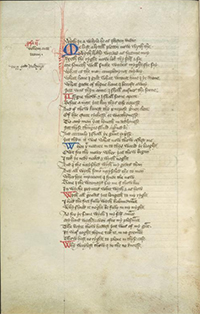PhD Fellow publishes manuscript description on Cambridge University Library
PhD fellow at the Centre for Privacy Studies, Anni Haahr Henriksen, has recently published her codicological and palaeographical description of CUL MS Gg.4.18 on the Cambridge University Library’s digital collection. MS Gg. 4.18 is a 15th century Middle English verse translation of Boethius’s Consolatione Philosophiae. In her description, Anni pays special attention to two pieces of marginalia, found on folios 20v and 33v. These two examples of marginalia and the form of textual engagement that they represent, Anni argues, imply a form of isolated communication with the text where the physical manuscript becomes a locus of private textual interaction. This ‘private textual interaction’, Anni argues, is unusual for its time and raises questions about medieval readers and reading practices.
Anni is currently working on a longer essay titled ‘CUL MS Gg.4.18 & the Private Reader’ that focuses solely on the two margin notes. The essay is available in the autumn of 2018 on the Cambridge Faculty of English Manuscripts Lab Blog.
More information:
Cambridge University Library MS Gg.4.18 is a medieval verse translation of Boethius’ Consolatione Philosophiae. The manuscript is a copy of the original translation conducted by John Walton, Canon of Osney, in 1410. Boethius wrote the Consolatione Philosophiae, around 520 AD and it is a highly influential philosophical work that in particular enjoyed great popularity in the English medieval period. The work was translated from Latin to Middle English on many occasions and one of the most famous medieval translators was the English poet Geoffrey Chaucer (1343-1400). The significance and relevance of Gg.4.18 for medieval scholars, however, does not simply lie in the title of its text proper nor in its popularity. It lies also in the physicality of the text. That is to say, how it is bound, how it is compiled, how it is written, which script was used, whether one or more scribes had written the text, which forms of decorations and initials were used and finally also whether non-scribal hands, that is to say, non-scribal additions, are present in the margins of the text. I address these questions in the description that accompanies the Cambridge University Digital Library’s digitization of MS Gg.4.18. And I also provide a diplomatic transcription of folios 20v and 21r along with a description of the provenance of the manuscript. In the manuscript description, I have paid particular attention to two margin notes in book two on folios 20v and 33v. These two notes are of special importance because they are testimonies of a highly subjective, if not private, form of textual engagement. Based on these two margin notes, I am currently finishing a short paper titled ‘MS Gg.4.18 and the Private Reader’. It will be published in the Autumn of 2018 on the Cambridge Faculty of English Manuscripts Lab Blog: https://www.english.cam.ac.uk/manuscriptslab/
Finally, this description and digitization of MS Gg.4.18 would not have been possible without the help and guidance of Prof. Orietta da Rold and Huw Jones, head of the Digital Library.
Anni Haahr Henriksen

